Assessment on Physical and Rheological Properties of Aged SBS Modified Bitumen Containing Rejuvenating Systems of Isocyanate and Epoxy Substances
Abstract
:1. Introduction
2. Experimental
2.1. Raw Materials
2.2. Aging Procedure of SMB
2.3. Rejuvenation for Aged SMB
2.4. Tests for Physical Properties
2.5. Tests for Rheological Properties
3. Results and Discussion
3.1. Effect of Rejuvenating Systems on the Physical Properties of Aged SMB
3.2. Effect of Rejuvenating Systems on the Physical Properties of Second Aged SMB
3.3. Effect of Rejuvenating Systems on the Viscous-Elastic Behavior of Aged SMB
3.4. Effect of Rejuvenating Systems on the Physical Properties of Aged SMB
3.5. Effect of Rejuvenating Systems on the Complex Modulus and Phase Angle of Aged SMB
3.6. Effect of Rejuvenating Systems on Rutting Factor of Aged SMB
3.7. Effect of Rejuvenation System on the Phase Angle of Second-Aged SMB
3.8. Effect of Rejuvenation System on the Damping Loss of Second-Aged SMB
4. Conclusions
- Both Rb and Rc rejuvenation systems of had significant advantages in contributing to improving the physical properties, including the ductility, penetration, and viscosity of aged SMB, while slightly reducing the softening point. Meanwhile, these kinds of rejuvenating systems were proved to still be applicable in the re-rejuvenation of re-aged binder.
- The results of viscous-elastic temperatures indicate that oxidative aging promotes the hardening caused from the agglomeration of binder molecules for fresh SMB, which leads to a sharp increase of the viscous-elastic temperature. However, with the rejuvenating systems, particularly Rb, the viscous-elastic temperature of rejuvenated SMB could be somewhat reduced to improve the low-temperature crack resistance.
- The obtained results on rutting factors indicate that the rejuvenating systems, especially Rb and Rc, are harmful to the high-temperature deformation resistance of rejuvenated SMB, but their performance level can still be close to that of fresh SMB with changing temperature.
- The results of damping loss demonstrated that vibration consumption for noise was improved for aged SMB with incorporated Rb and Rc in the form of viscous loss, and furthermore, the effects for re-aged SMB using the same rejuvenating systems were weakened but still effective.
- We recommend the use of rejuvenating systems containing epoxy—with or without isocyanate—for recycling aged SBS asphalt binder for application in the mid-temperature region. The disadvantage of rejuvenated binder lies in its poorer high-temperature workability. Despite that, more considerations regarding the performance restoration of degraded polymer in binder should be examined in future work.
Author Contributions
Funding
Acknowledgments
Conflicts of Interest
References
- Zhao, X.Y.; Wang, S.F.; Wang, Q.; Yao, H.R. Rheological and structural evolution of SBS modified asphalts under natural weathering. Fuel 2016, 184, 242–247. [Google Scholar] [CrossRef]
- Durrieu, F.; Farcas, F.; Mouillet, V. The influence of UV aging of a styrene/butadiene/styrene modified bitumen: Comparison between laboratory and on site aging. Fuel 2007, 86, 1446–1451. [Google Scholar] [CrossRef]
- Cong, P.; Luo, W.; Xu, P.; Zhao, H. Investigation on recycling of SBS modified asphalt binders containing fresh asphalt and rejuvenating agents. Constr. Build. Mater. 2015, 91, 225–231. [Google Scholar] [CrossRef]
- Xu, X.; Yu, J.Y.; Wang, R.Y.; Hu, J.X.; Xue, L.H. Investigation of road performances of reaction-rejuvenated SBS modified bitumen mixture. Constr. Build. Mater. 2018, 183, 523–533. [Google Scholar] [CrossRef]
- Xiao, F.P.; Putman, B.; Amirkhanian, S. Rheological characteristics investigation of high percentage RAP binders with WMA technology at various aging states. Constr. Build. Mater. 2015, 98, 315–324. [Google Scholar] [CrossRef]
- Yan, C.Q.; Xiao, F.P.; Huang, W.; Quan, L. Critical matters in using Attenuated Total Reflectance Fourier Transform Infrared to characterize the polymer degradation in Styrene–Butadiene–Styrene-modified asphalt binders. Polym. Test. 2018, 70, 289–296. [Google Scholar] [CrossRef]
- Xu, S.; Yu, J.Y.; Hu, C.B.; Qin, D.F.; Xue, L.H. Laboratory evaluation of rejuvenation effect of reactive rejuvenator on aged SBS modified bitumen. Mater. Struct. 2017, 50, 233. [Google Scholar] [CrossRef]
- Nian, T.F.; Li, P.; Wei, X.Y.; Wang, P.H.; Li, H.S.; Guo, R. The effect of freeze-thaw cycles on durability properties of SBS-modified bitumen. Constr. Build. Mater. 2018, 187, 77–88. [Google Scholar] [CrossRef]
- Xu, X.; Yu, J.Y.; Xue, L.H.; He, B.Y.; Du, W.; Zhang, H.; Li, Y. Effect of reactive rejuvenating system on physical properties and rheological characteristics of aged SBS modified bitumen. Constr. Build. Mater. 2018, 176, 35–42. [Google Scholar] [CrossRef]
- Poulikakos, L.D.; Santos, S.; Bueno, M.; Kuentzel, S.; Hugener, M.; Partl, M.N. Influence of short and long term aging on chemical, microstructural and macro-mechanical properties of recycled asphalt mixtures. Constr. Build. Mater. 2014, 51, 414–423. [Google Scholar] [CrossRef]
- Xu, X.; Yu, J.Y.; Zhang, C.L.; Cao, Z.L.; Gu, Y.; Xue, L.H. Effect of reactive rejuvenators on structure and properties of UV-aged SBS modified bitumen. Constr. Build. Mater. 2017, 155, 780–788. [Google Scholar] [CrossRef]
- Singh, S.K.; Kumar, Y.; Ravindranath, S.S. Thermal degradation of SBS in bitumen during storage: Influence of temperature, SBS concentration, polymer type and base bitumen. Polym. Degrad. Stabil. 2018, 147, 64–75. [Google Scholar] [CrossRef]
- Wang, T.; Xiao, F.P.; Amirkhanian, S.; Huang, W.D.; Zheng, M.L. A review on low temperature performances of rubberized asphalt materials. Constr. Build. Mater. 2017, 145, 483–505. [Google Scholar] [CrossRef]
- Hao, J.T.; Cao, P.Y.; Liu, Z.H.; Wang, Z.X.; Xia, S.F. Developing of a SBS polymer modified bitumen to avoid low temperature cracks in the asphalt facing of a reservoir in a harsh climate region. Constr. Build. Mater. 2017, 150, 105–113. [Google Scholar] [CrossRef]
- RRasool, T.; Yao, H.R.; Hassan, A.; Wang, S.F.; Zhang, H.Y. In-field aging process of high content SBS modified asphalt in porous pavement. Polym. Degrad. Stabil. 2018, 155, 220–229. [Google Scholar] [CrossRef]
- Chen, M.Z.; Xiao, F.P.; Putman, B.; Leng, B.B.; Wu, S.P. High temperature properties of rejuvenating recovered binder with rejuvenator, waste cooking and cotton seed oils. Constr. Build. Mater. 2014, 59, 10–16. [Google Scholar] [CrossRef]
- Zhu, H.; Xu, G.; Gong, M.; Yang, J. Recycling long-term-aged asphalts using bio-binder/plasticizer-based rejuvenator. Constr. Build. Mater. 2017, 147, 117–129. [Google Scholar] [CrossRef]
- Qiu, Y.J.; Ding, H.B.; Rahman, A.; Wang, W.Q. Damage characteristics of waste engine oil bottom rejuvenated asphalt binder in the non-linear range and its microstructure. Constr. Build. Mater. 2018, 174, 202–209. [Google Scholar] [CrossRef]
- Asli, H.; Ahmadinia, E.; Zargar, M.; Mohamed, R.K. Investigation on physical properties of waste cooking oil–rejuvenated bitumen binder. Constr. Build. Mater. 2012, 37, 398–405. [Google Scholar] [CrossRef]
- Zargar, M.; Ahmadinia, E.; Asli, H.; Karim, M.R. Investigation of the possibility of using waste cooking oil as a rejuvenating agent for aged bitumen. J. Hazard. Mater. 2012, 233, 254–258. [Google Scholar] [CrossRef]
- Gong, M.H.; Yang, J.; Zhang, J.Y.; Zhu, H.R.; Tong, T.Z. Physical-chemical properties of aged asphalt rejuvenated by bio-oil derived from biodiesel residue. Constr. Build. Mater. 2016, 105, 35–45. [Google Scholar] [CrossRef]
- Chen, M.Z.; Leng, B.B.; Wu, S.P.; Sang, Y. Physical, chemical and rheological properties of waste edible vegetable oil rejuvenated asphalt binders. Constr. Build. Mater. 2014, 66, 286–298. [Google Scholar] [CrossRef]
- Xu, X.; Yu, J.Y.; Xue, L.H.; Zhang, C.L.; Zha, Y.G.; Gu, Y. Investigation of Molecular Structure and Thermal Properties of Thermo-Oxidative Aged SBS in Blends and Their Relations. Materials 2017, 10, 768. [Google Scholar] [CrossRef] [PubMed]
- Xu, X.; Yu, J.Y.; Zhang, C.L.; Xu, S.; Xue, L.H.; Xie, D. Investigation of aging behavior and thermal stability of styrene-butadiene-styrene tri-block copolymer in blends. Polymer (Korea) 2016, 40, 947–953. [Google Scholar] [CrossRef]
- Wu, S.P.; Pang, L.; Mo, L.T.; Chen, Y.C.; Zhu, G.J. Influence of aging on the evolution of structure, morphology and rheology of base and SBS modified bitumen. Constr. Build. Mater. 2009, 23, 1005–1010. [Google Scholar] [CrossRef]
- Singh, R.P.; Desai, S.M.; Solanky, S.S.; Thanki, P.N. Photodegradation and stabilization of styrene-butadiene-styrene rubber. J. Appl. Polym. Sci. 2000, 75, 1103–1114. [Google Scholar] [CrossRef]
- Standard Practice for Accelerated Aging of Asphalt Binder Using a Pressurized Aging Vessel (PAV); ASTM D6521; ASTM International: West Conshohocken, PA, USA, 2018.
- Standard Test Method for Viscosity Determination of Asphalt at Elevated Temperatures Using a Rotational Viscometer; ASTM D4402; ASTM International: West Conshohocken, PA, USA, 2015.
- Standard Test Method for Softening Point of Bitumen (Ring-and-Ball Apparatus); ASTM D36; ASTM International: West Conshohocken, PA, USA, 2014.
- Standard Test Method for Penetration of Bituminous Materials; ASTM D5; ASTM International: West Conshohocken, PA, USA, 2013.
- Standard Test Method for Ductility of Asphalt Materials; ASTM D113; ASTM International: West Conshohocken, PA, USA, 2017.
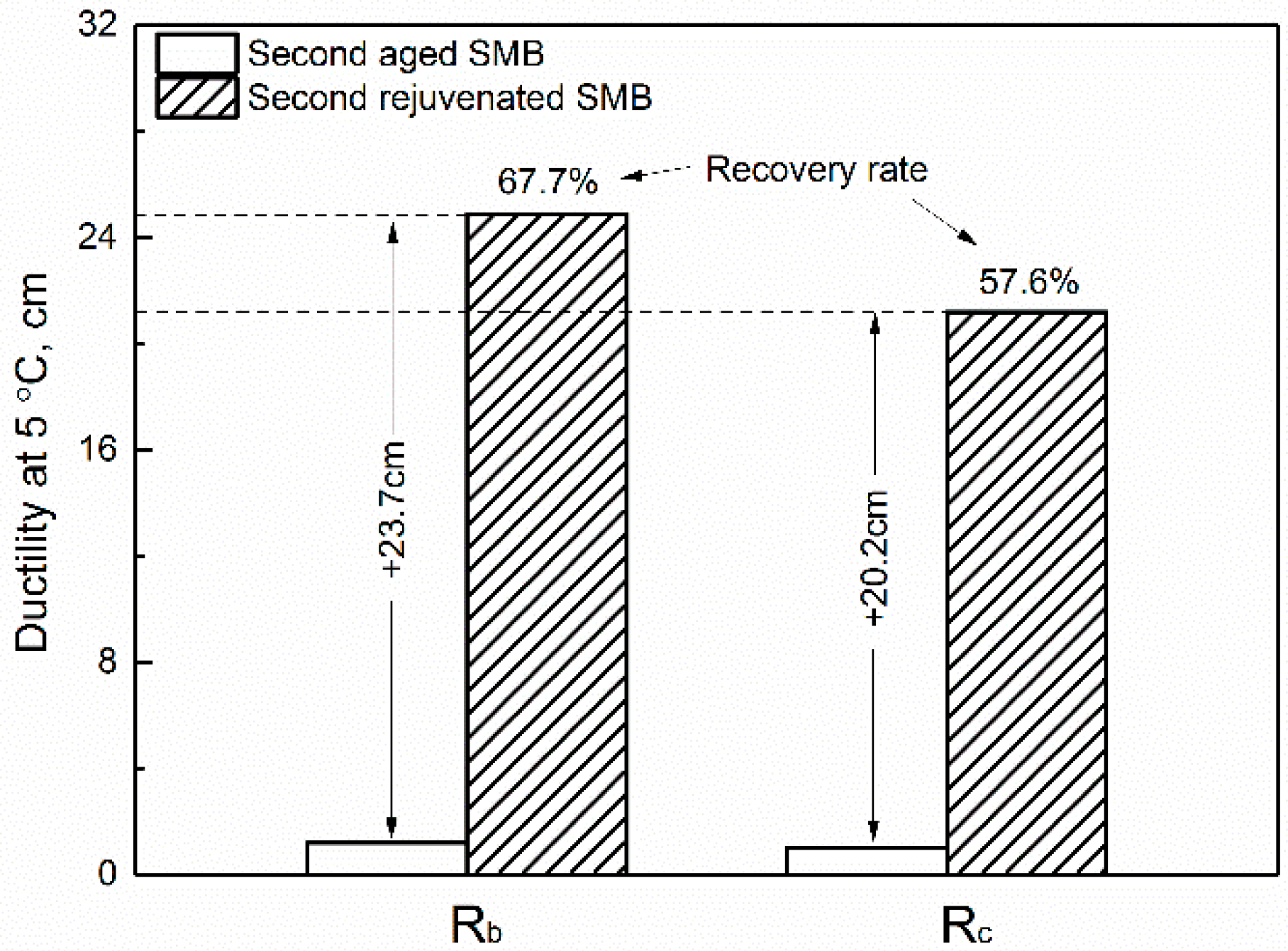

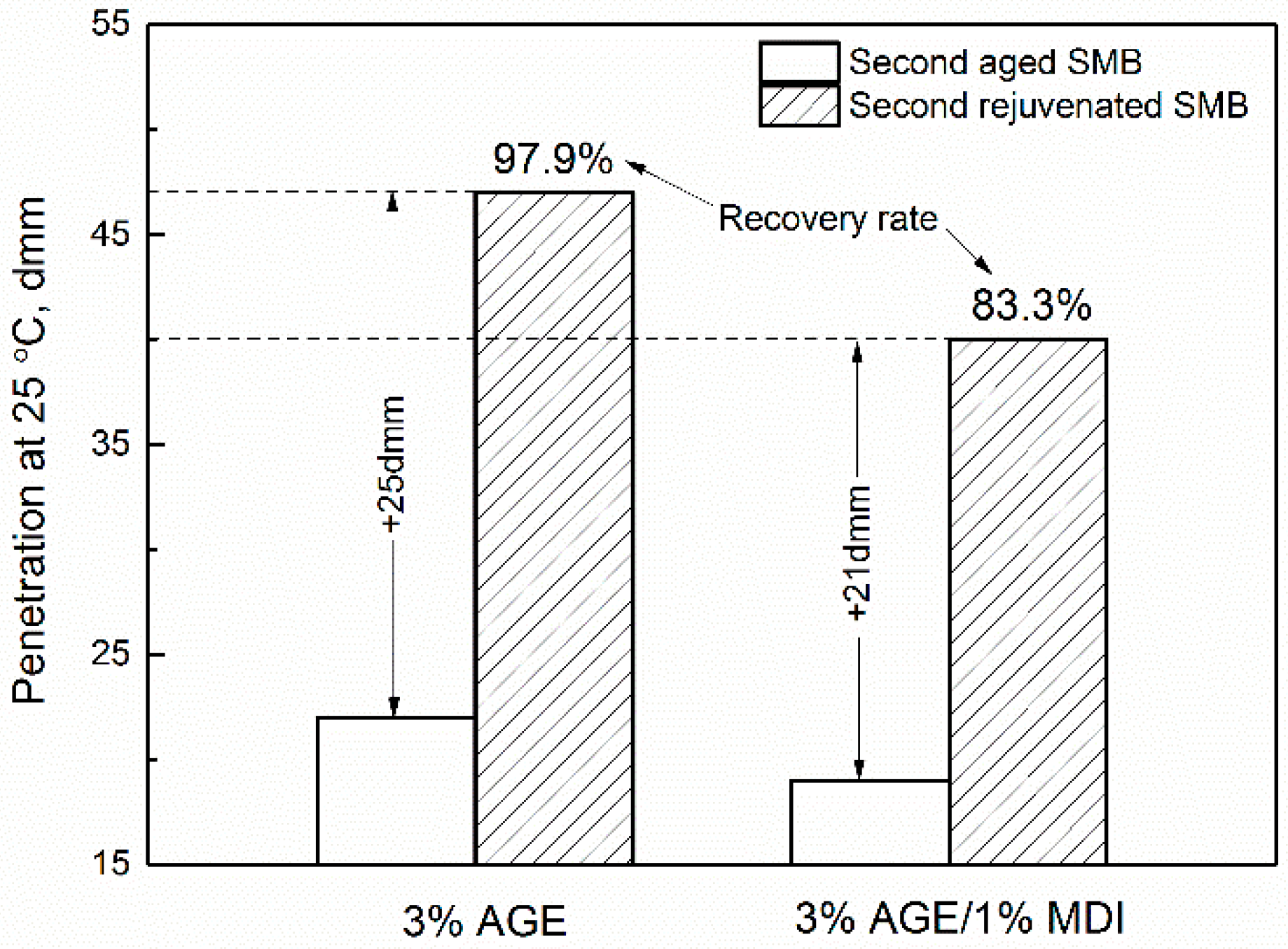

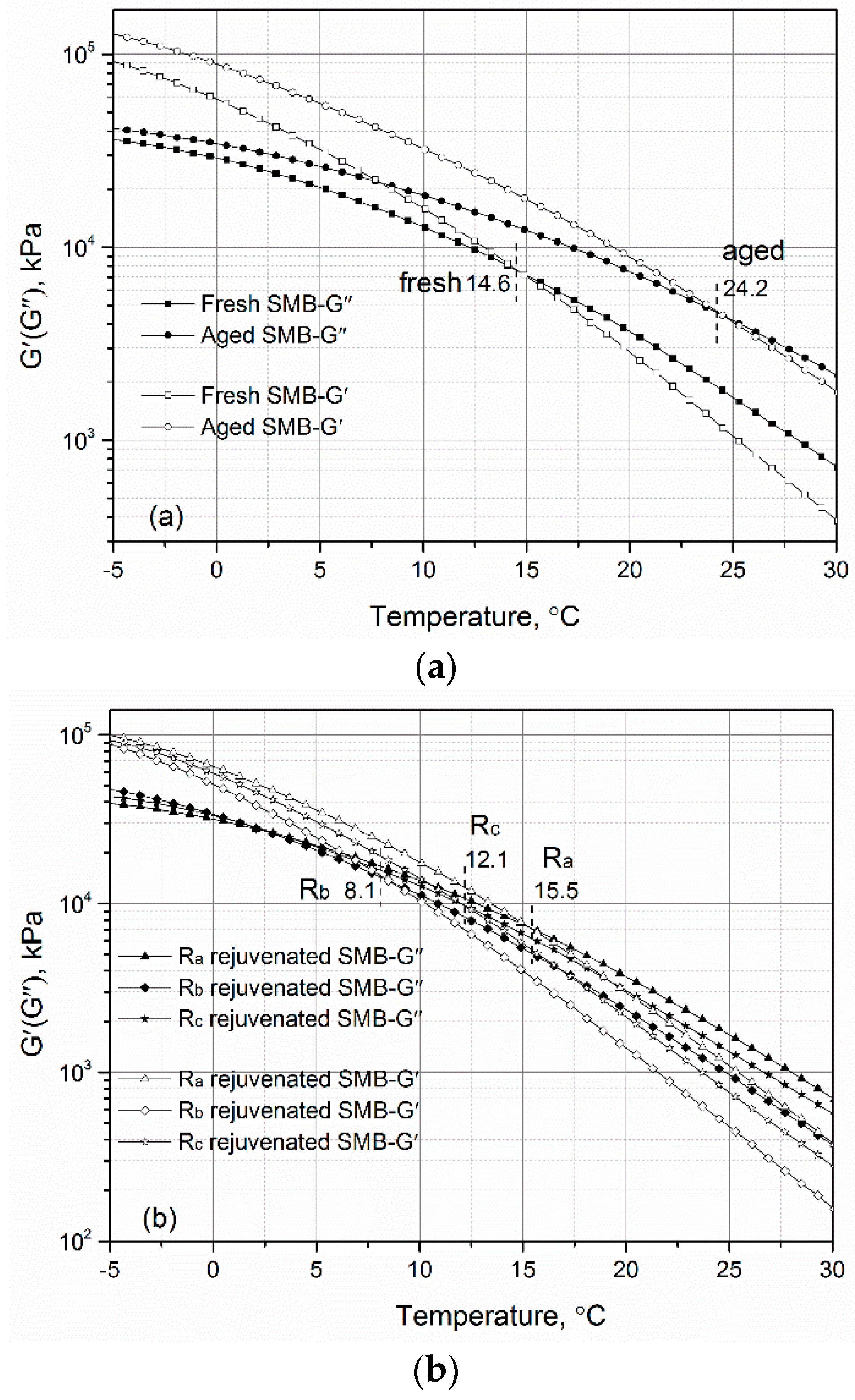

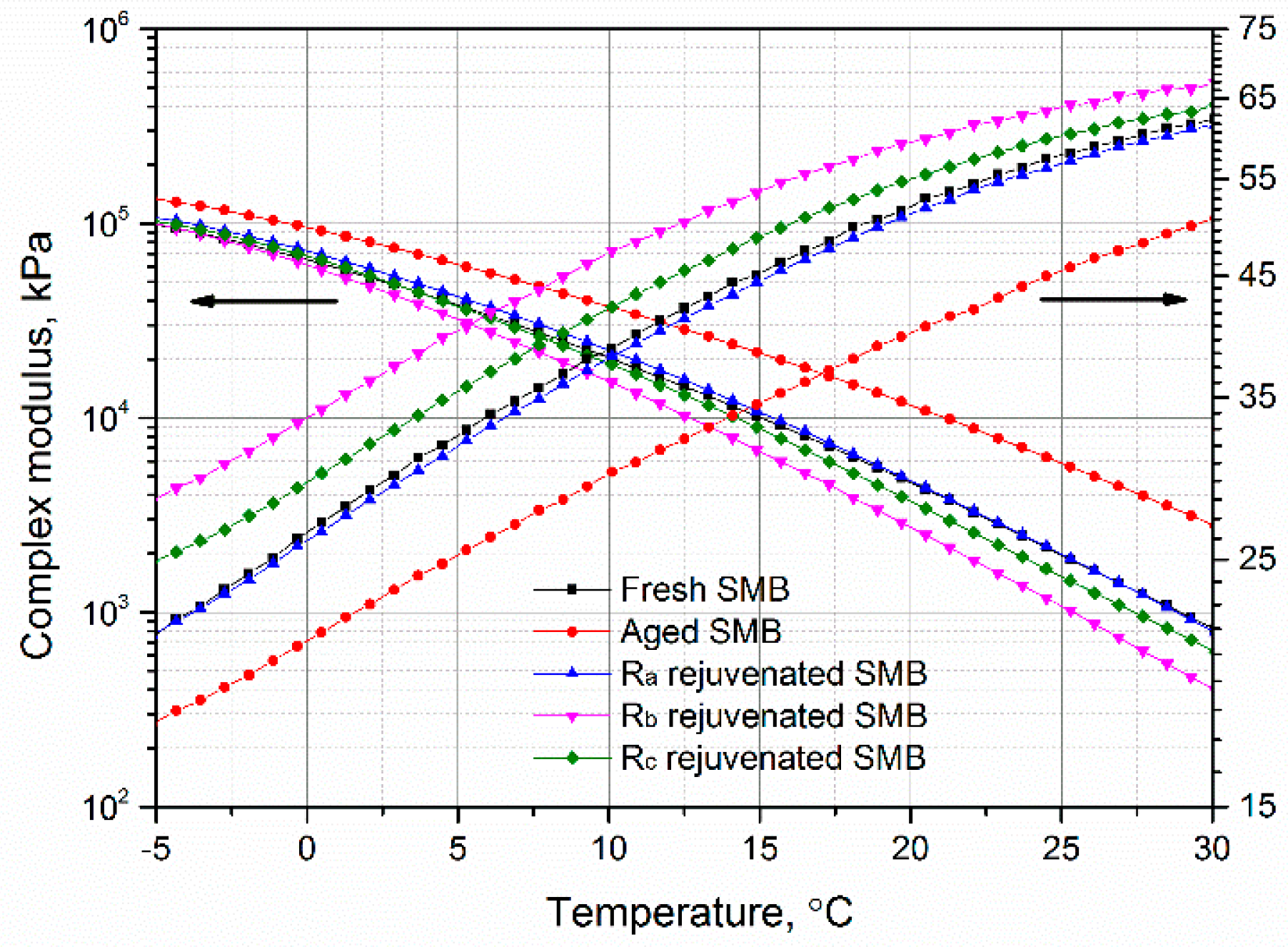
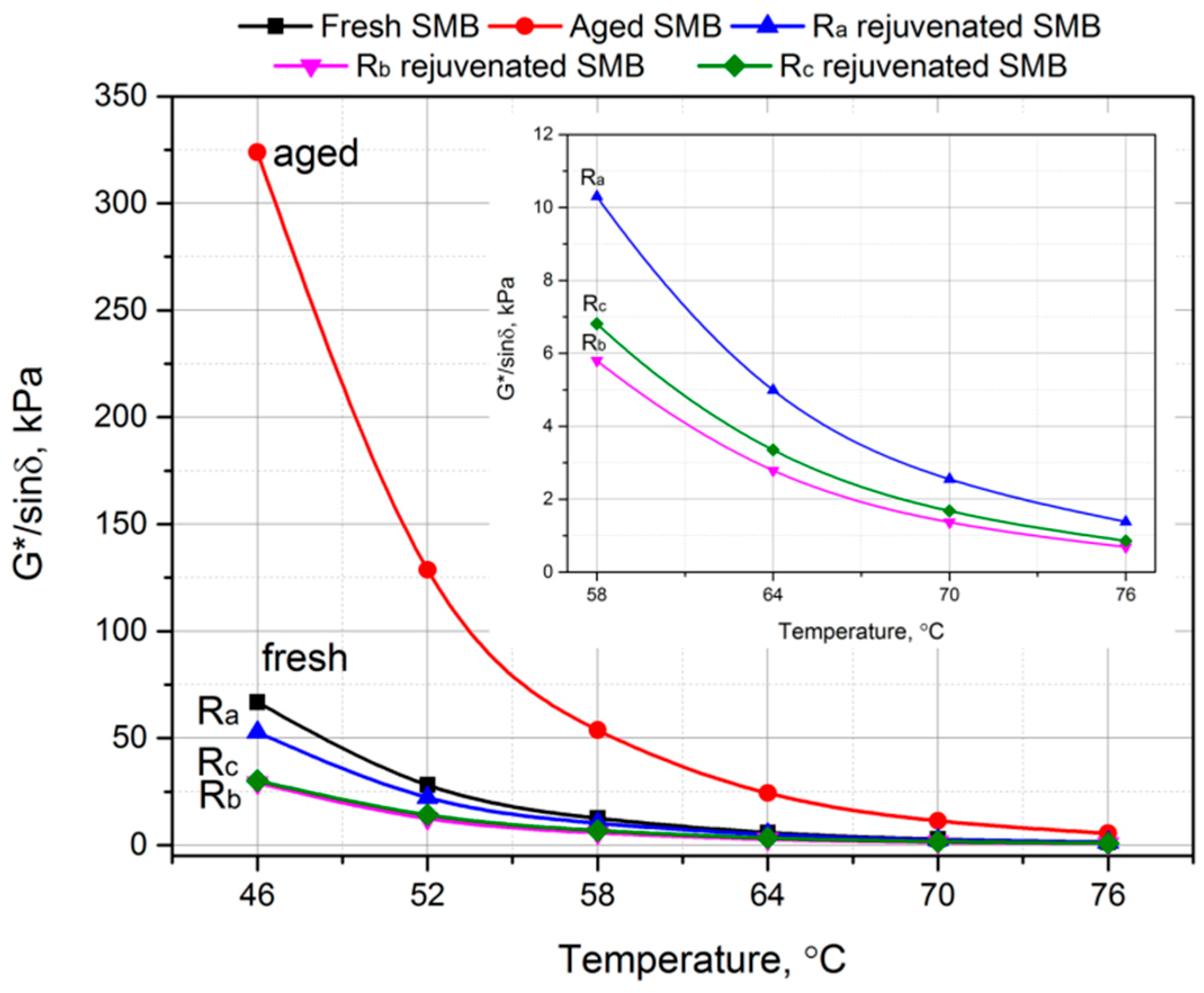

| Technical Index | Fresh SMB | PAV-Aged SMB |
|---|---|---|
| Ductility at 5 °C (cm) | 36.8 | 1.2 |
| Softening point (°C) | 70.5 | 63.1 |
| Viscosity at 135 °C (Pa·s) | 2.56 | 2.85 |
| Penetration at 25 °C (dmm) | 48 | 17 |
| Technical Index | Aged SMB | Rejuvenated SMB | Equation | ||
|---|---|---|---|---|---|
| Ra | Rb | Rc | |||
| Ductility at 5 °C (cm) | 1.2 | 13.6 | 28.2 | 24.7 | - |
| Softening point (°C) | 63.1 | 56.2 | 50.5 | 55.8 | - |
| Penetration at 25 °C (dmm) | 17 | 34 | 54 | 47 | - |
| Viscosity at 135 °C (Pa·s) | 2.85 | 1.15 | 0.96 | 1.26 | - |
| Ductility recovery rate (%) | - | 37.0 | 76.6 | 67.1 | |
| Softening point retention rate (%) | - | 79.7 | 71.6 | 79.1 | |
| Penetration recovery rate (%) | - | 70.8 | 112.5 | 95.9 | |
| Viscosity index (%) | - | 44.9 | 37.5 | 49.2 | |
| Samples | δ, ° | Tan δ | ||
|---|---|---|---|---|
| 5 °C | 60 °C | 5 °C | 60 °C | |
| First-rejuvenated SMB containing Rc | 35.8 | 70.1 | 0.72 | 2.76 |
| Second-rejuvenated SMB containing Rc | 31.8 | 66.9 | 0.62 | 2.34 |
© 2019 by the authors. Licensee MDPI, Basel, Switzerland. This article is an open access article distributed under the terms and conditions of the Creative Commons Attribution (CC BY) license (http://creativecommons.org/licenses/by/4.0/).
Share and Cite
Li, Z.; Xu, X.; Yu, J.; Wu, S. Assessment on Physical and Rheological Properties of Aged SBS Modified Bitumen Containing Rejuvenating Systems of Isocyanate and Epoxy Substances. Materials 2019, 12, 618. https://doi.org/10.3390/ma12040618
Li Z, Xu X, Yu J, Wu S. Assessment on Physical and Rheological Properties of Aged SBS Modified Bitumen Containing Rejuvenating Systems of Isocyanate and Epoxy Substances. Materials. 2019; 12(4):618. https://doi.org/10.3390/ma12040618
Chicago/Turabian StyleLi, Zhelun, Xiong Xu, Jianying Yu, and Shaopeng Wu. 2019. "Assessment on Physical and Rheological Properties of Aged SBS Modified Bitumen Containing Rejuvenating Systems of Isocyanate and Epoxy Substances" Materials 12, no. 4: 618. https://doi.org/10.3390/ma12040618
APA StyleLi, Z., Xu, X., Yu, J., & Wu, S. (2019). Assessment on Physical and Rheological Properties of Aged SBS Modified Bitumen Containing Rejuvenating Systems of Isocyanate and Epoxy Substances. Materials, 12(4), 618. https://doi.org/10.3390/ma12040618







